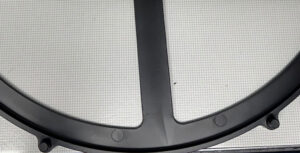Difference Between Knit and Meld Lines in Injection Molding
Have you ever wondered how your favorite plastic products achieve such flawless finishes and lasting durability? The answer often lies in the precise art of injection molding, where raw materials are transformed into everyday essentials. In this process, terms like knit lines and meld lines frequently arise. At The Toolroom, we specialize in expert injection molding services and are here to help you understand the difference between these lines, enhancing your overall molding experience.
 Knit lines, also known as weld lines, occur when two or more flow fronts in the molten plastic meet and fail to bond perfectly. This can be due to differences in temperature, speed, or pressure. Knit lines can sometimes be weak points in a product, potentially affecting its strength or appearance. However, not all knit lines are detrimental. In fact, for products that don’t require high strength, such as cosmetic containers or decorative parts, knit lines might be perfectly acceptable.
Knit lines, also known as weld lines, occur when two or more flow fronts in the molten plastic meet and fail to bond perfectly. This can be due to differences in temperature, speed, or pressure. Knit lines can sometimes be weak points in a product, potentially affecting its strength or appearance. However, not all knit lines are detrimental. In fact, for products that don’t require high strength, such as cosmetic containers or decorative parts, knit lines might be perfectly acceptable.
Meld lines, on the other hand, are formed under more favorable conditions than knit lines. When molten plastic flows meet with similar temperatures and pressures, they blend more seamlessly, creating a stronger bond. Meld lines are often found in products that require high structural integrity, like automotive components or medical devices. These lines ensure that the product is both functional and reliable.
Choosing between knit and meld lines depends on the intended use of your product. Are you producing something that requires high durability, like a bicycle helmet? Then meld lines are your best bet due to their enhanced strength. Conversely, if you’re crafting decorative items where appearance trumps strength, knit lines may suffice.
Why does understanding the difference between knit and meld lines in injection molding matter? As you plan your project, consider the following factors:
- Aesthetic quality. If your project demands a flawless finish—think high-end consumer goods or visible components—then minimizing or eliminating these lines is crucial. In these cases, controlling flow fronts and choosing the right material can be key to success.
- Structural integrity. For parts that need to withstand stress, such as automotive or industrial components, meld lines may be preferable as they typically provide more strength than knit lines.
- Production efficiency. Both knit and meld lines are a natural part of the injection molding process, but depending on the shape and complexity of the part, controlling these lines may require adjustments to the mold design, the material used, or the injection pressure.
Start with a consultation with The Toolroom experts who carefully analyze your specific needs. Our team provides personalized guidance to ensure your products are molded to perfection, balancing aesthetics and functionality. The Toolroom stands out not only for our technical prowess but also for our customer-centric approach. We work closely with clients to understand your unique requirements, ensuring that every project is a success. By choosing The Toolroom, you’re not just getting a service—you’re gaining a partner in innovation. Connect with The Toolroom today and experience the difference firsthand at (573) 437-4154.
